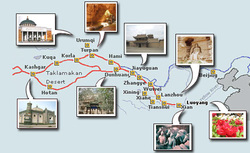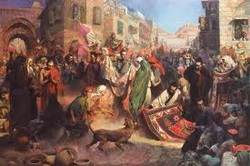The Silk Road
Description
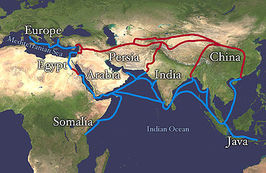
The Silk Road is a series of trade routes throughout the continents of Asia, Europe, and Africa. There was never just one route, meaning that there were many different ways you could travel. Most routes that traveled East where changed to accomodate the cities and towns that were along the oasis in the deserts (Wild, 1992). The main hub for the trade routes started in the capital city of Changan. The main priority of this route was to trade goods with other countries in order to get what was needed in China (Wild, 1992). The most popular time for the Silk Road was during the middle of the Tang Dynasty, right before China was taken over by the Huns of Mongolia (Maconi, Daniels & Onyinye, 2001).
History of the Silk Road
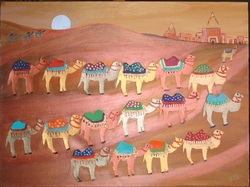
The Silk Road is the most well know trading route in all of the ancient world. It started out during the end of the Hun Dynasty, years 135 to 90 B.C. (Marconi). This route was origanially used to trade silk internally through out Central and Eastern China. The trades were made by caravans escorted by Chinese soldiers. The escorts were used as a defense towards the attacking nomads and Hun Armies. In the years that followed, China began to get tired of trade within the country and decided to expand. the first known trade with another country was with the Roman Empire. the first trade with Rome was not necessarily a trade at all. The Chinese government had decided to try and make peace with Rome, so the decided to gift massive amounts of silk to the Romans (Marconi). This gift to the Romans ended up expanding the trade route to farther regions in Europe. These trades helped popularity of the trade route grow and after the initial trade to the Romans, Easten Europe opened up to trade with China (Marconi).
The Traded Goods
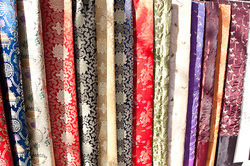
Trades across the Silk Road were not just primarily silk. The silk was just the product that traveled east accros the trade route. The most common trades occured from West to East and vice versa.
From the Mediteranian Region: The silk traveled the road until it reached the Mediteranian region, where is was traded for woolen goods, carpets, tapestries, blankets, and rugs. These goods werer taken eastward and often traded for other goods (Advantour, 2001-2001).
From the South Eastern Asian Region: The trades from the Mediteranian region would travel eastward towards the South Easten Regions of Asia. Here the goods would be traded for Goods like fabrics, spices, precious stones, dyes, and ivory. These goods were important to China because they brought in not only money, but the dyes neede to create more exotic silks (Advantour, 2001-2011).
From the African Region: The last stop on the trade route was the African Region. Here all the goods that were obtained thus far were traded for things like precious furs, exotic skins, slaves, bronze, sugar, and more ivory. These goods were taken back to China where they were sold or kept as priceless goods. more often than not, the goods were sent back East to do more trades (advantour, 2001-2011).
From the Mediteranian Region: The silk traveled the road until it reached the Mediteranian region, where is was traded for woolen goods, carpets, tapestries, blankets, and rugs. These goods werer taken eastward and often traded for other goods (Advantour, 2001-2001).
From the South Eastern Asian Region: The trades from the Mediteranian region would travel eastward towards the South Easten Regions of Asia. Here the goods would be traded for Goods like fabrics, spices, precious stones, dyes, and ivory. These goods were important to China because they brought in not only money, but the dyes neede to create more exotic silks (Advantour, 2001-2011).
From the African Region: The last stop on the trade route was the African Region. Here all the goods that were obtained thus far were traded for things like precious furs, exotic skins, slaves, bronze, sugar, and more ivory. These goods were taken back to China where they were sold or kept as priceless goods. more often than not, the goods were sent back East to do more trades (advantour, 2001-2011).
The Death of the Silk Road
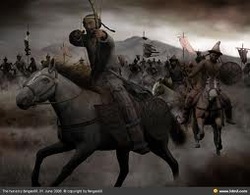
Trade along the Silk Road started to dcline towards the end of the Tang Dynasty. This happened because of the decline of the Roman Empire, and the cities that regained control wanted nothing to do with affiliations of the Romans. This however was not the true decline of the Silk Road. The true end of the trading route was when Mongolia and the Huns gained control over China. It was at this point that the trade route was only used to gain perfumes, slaves, and precious stones for the Mongols (Marconi). The trade died down and now all that is left is the historyof one the greatest trade routes known today as the Silk Road.
References
Advantour. (2001-2011). Goods of the silk road. Retrieved from www.advantour.com/silkroad/goods.html
Marconi, M., Daniels, , & Onyinye (2001). The silk road: linking europe and asia through trade. Retrieved from library.thinkquest.org/13406/sr/
Wild, O. (1992). The silk road. Retrieved from www.ess.uci.edu/~oliver/silk.html
Marconi, M., Daniels, , & Onyinye (2001). The silk road: linking europe and asia through trade. Retrieved from library.thinkquest.org/13406/sr/
Wild, O. (1992). The silk road. Retrieved from www.ess.uci.edu/~oliver/silk.html
